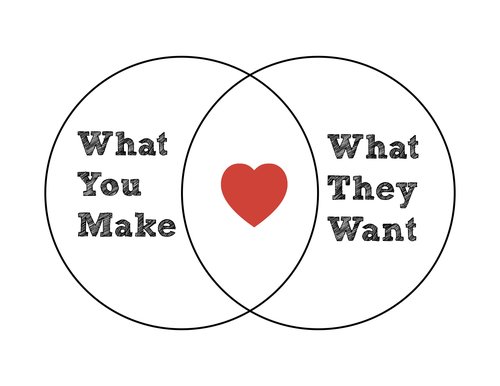by Carolyn Edlund
Making art and selling art are very different things. Doing both in your small business requires different mindsets.
The art that you make is valid, no matter whether you sell it or not. But if you do plan to sell, you must understand the nature of business, and the reality that making art doesn’t always equal selling art.
Your inspired state of mind in the studio helps you design, innovate and create amazing art. Making sales, however, involves someone else’s mindset—that of your customer. What do customers care about most? Themselves. They want what makes them happy or fills a perceived need.
The Venn diagram on this page illustrates the relationship between what you make in the studio, and what people want to buy. Where they cross over is your sweet spot. Hopefully a diagram showing your results would have a very large sweet spot, reflecting that you love what you are doing, and that other people love much of what you make. That’s a perfect situation.
The more you know about what your audience wants and needs, and how to communicate the ways that your art is a perfect fit for them, the more you can tailor your marketing content and your sales presentation to successfully make sales.
Nobody cares as much about your art business as you do.
This simple fact speaks to your mindset more than anything. Are you willing to take ultimate responsibility for making sales of your work and growing your small business? As an entrepreneur, founder and CEO as well as an artist, it’s up to you to set goals and create systems and business practices to meet them.
A mature fine artist reflected on his successful career. He had been selling his paintings for many years, developing a base of over 800 collectors. In addition, four art galleries represented him. The artist stated “Most of the sales I’ve made have not been through my galleries. I’ve sold them myself.” The artist maintained that his mindset was his most powerful tool, knowing that he had more ability than anyone to connect and engage with potential customers. He took the initiative, and used that to build a solid foundation for his business.
Artists who shun the business side of art, and want to turn everything over to an agent or representative, may be doing themselves a great disservice. It’s understandable that they don’t want to deal with the sales side of things. But what will happen if their representative quit, or retired? Or if they never find anyone at all to run “the business side” of things?
The more you know about your customers and their mindset, and the more you cultivate your own entrepreneurial mindset, the better. Although art can be very personal to the artist, sales are business transactions. Finding a balance between the two will allow you to gain more collectors and earn more while doing what you love.
Want to stay current on cutting edge business articles from Artsy Shark, plus artist features, and an invitation to the next Call for Artists? Click below to sign up for our twice-monthly email. You’ll get all this plus opportunities and special offers that you can’t get anywhere else!
